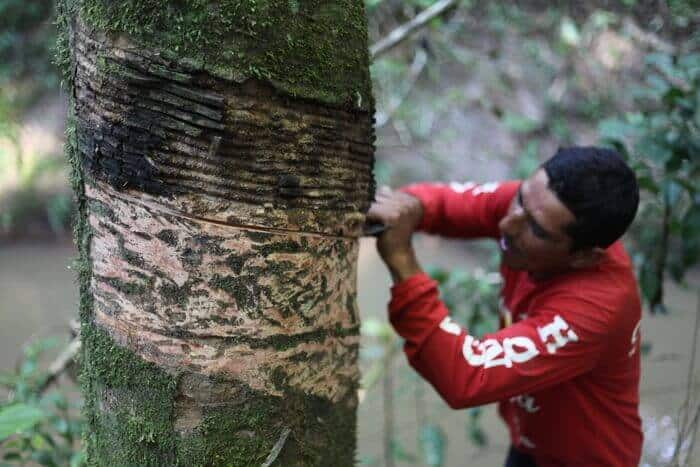Principles and examples for developing regenerative businesses in tropical forest landscapes.

At a recent Restoration Factory seminar for entrepreneurs working on regenerative businesses in tropical forest landscapes, P4F shared principles and examples of how payments for ecosystem services can be accessed to support business development. Here are some key takeaways.
Reforesting land areas, preventing logging, or cleaning up waterways are all critical steps towards maintaining biodiversity and reducing emissions – benefits that help the global community, as well as those who rely on an ecosystem.
Farmers and landowners living close to environmentally valuable land or water systems are often the people best placed to carry out these kinds of restoration activities – but doing so takes time, effort, and has an opportunity cost.
This is where Payments for Ecosystem Services (PES) come in. PES aim to incentivise environmentally protective – or restorative – practices by offering payments, similar to subsidies, to those who undertake them.
Payments are generally made by those who are beneficiaries of the ecological services – for example, water users and hydropower companies who benefit from a polluted waterway being cleaned up.
The ecological services can take a huge variety of forms – from fairly straightforward activities such as creating wind breaks or dispersing seeds, through to detoxifying waste, or purifying water.
They can focus on, among other things, protecting biodiversity (by protecting high-value habitat, for instance), avoiding deforestation, reforesting, or climate stabilisation.
How to make PES models that work
While PES can incentivise practices that are incredibly beneficial for the environment, as well as providing an income and business experience to those in rural areas, it is a system that needs to be finely balanced. For a PES system to work efficiently and effectively, some core principles must be incorporated: involvement must be voluntary; it must be ‘beneficiary pays’; actions must have additionality; and conditionality – payments must be dependent on the delivery of ecosystem benefits -; permanence must be ensured; and leakage must be avoided.
The configuration of a PES system must also be considered, which could see payments set up one-to-one (e.g. a company contracting a single major landowner to provide carbon sequestration); one-to-many (e.g. a water utility contracting, through a broker, many farm businesses for water-sensitive practices); many-to-one (e.g. multiple buyers investing in the development of urban green space); or many-to-many (e.g. a government paying farmers for sympathetic land management practices).
With principles and configuration taken into account, we can consider the other factors that need to be in place for PES revenues to flow. They are:
- Business case/justification
- Finance – a) short-term design and capacity building costs, b) long-term implementation costs, and c) up-front costs for research, data collection and stakeholder engagement.
- Transaction costs – the potentially substantial costs of administration (e.g. aggregating buyers/sellers). Should be mitigated as much as possible.
- An appropriate legislative/legal environment – Some countries/ecosystems have a stronger basis for PES than others.
A business case or justification must include an accurate estimation of costs, including transaction costs and the payments themselves. Payments must be high enough to fully cover all costs to the seller, incentivise the seller to provide the service over the long term, and ensure that potential income that could have been made from other uses of the land is offset.
Sellers can benefit from a cash income and business experience, but there are also potential risks in being involved with a PES system. Among them are a loss of rights to harvest products; opportunity costs (including reduced opportunities from donors/aid organisations); loss of control over local development options; and unfair outcomes – like unfair sharing of net revenues. Sellers can also go into the contract on an uneven footing if they have an inadequate understanding of what is being bought and sold.

PES in action: Veja Fair Trade case study
In this PES model, French shoe company Veja – which sources its rubber from producer cooperatives in the Brazilian Amazon – created a protocol for assuring sustainability within its rubber supply chain and maintaining the accreditation of its suppliers.
The sustainability criteria under this protocol include rubber quality, good harvesting practices, and alignment to the use of the land. Rubber suppliers who meet these criteria are eligible to receive a premium price.
Once the eligibility criteria are met, Veja pays the premium directly to Cooperacre, a cooperative responsible for receiving and processing the latex, who then redirect the payments to the rubber collectors.
Several initiatives were put in place to ensure the success of the Veja PES model. To ensure adherence to the deforestation limit criteria, an automated monitoring platform was developed to assess the level of deforestation in the supply chain. And several forums were created for representatives of collector cooperatives, Veja, and Cooperacre, to be collective spaces for dialogues and decision making.
What factors have worked in this PES model? Good communication between Veja, Cooperacre, cooperatives and collectors was essential to promote strong relationships, with clear engagement processes to resolve commercial issues, monitoring and PES Protocol implementation.
There was also a long process of dialogue with partners that resulted in important more detailed understanding of the Veja team and a view about current challenges and needs for future implementation of the PES Protocol in order to maximise conditions to guarantee a sustainable rubber supply chain.
However, the project has also faced some areas of concern – the deforestation modelling platform does not assign direct responsibility to a specific collector/s, as Veja does not have the exact property limits, but instead presents a deforestation risk analysis in ‘influence areas’. This presents a liability issue that will need to be managed on an ongoing basis.
Making transactions transformational
At the surface level, PES can seem like a universally beneficial, appealing system. And, administered with care and thoroughness, it can indeed be a win-win for communities and the planet. However, there are challenges and roadblocks inherent to PES – not every case in which people express interest in PES will result in actual transactions actually being conducted.
Identifying realistic ecosystem service prospects and potential buyers is a critical first step.
Setting up PES systems is not a quick or simple solution, and building technical and institutional capacity is often required before models can be implemented. However, with time, commitment and ongoing dialogue, PES agreements can have a transformative effect – for both communities and ecosystems
This information was originally presented by Martin Belcher, Partnerships for Forests Director, Monitoring, Evaluation and Learning, at a seminar for the Restoration Factory aimed at entrepreneurs working on regenerative businesses in tropical forest landscapes,
